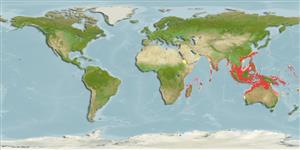ইলাসমোব্রাঙ্কি (হাঙ্গর এবং রে) (sharks and rays) >
Carcharhiniformes (Ground sharks) >
Hemigaleidae (Weasel sharks)
Etymology: Hemigaleus: hemi-, from hemisys (Gr.), half, referring to similarity to and/or close affinity with Galeus (now in Pentanchidae) (See ETYFish); microstoma: micro-, from mikros (Gr.), small; stoma (Gr.), mouth, referring to very short arched mouth compared with Chaenogaleus macrostoma, its presumed congener at the time (See ETYFish).
More on author: Bleeker.
Issue
Specimens from Australia (and probably Papua New Guinea) are placed in Hemigaleus australiensis White, Last & Compagno, 2005 (Ref. 56150).
Environment: milieu / climate zone / depth range / distribution range
বাস্তুসংস্থান
সামুদ্রিক তলদেশ বিহারী. Tropical; 22°C - 28°C (Ref. 244); 28°N - 30°S
Indo-West Pacific: southern India and Sri Lanka; China to Indonesia (Ref. 56150). Also from Red Sea (Ref. 93009).
Specimens found in Australia (and probably Papua New Guinea) belong to a separate species, Hemigaleus australiensis (Ref. 56150).
Length at first maturity / আকৃতি / ওজন / Age
Maturity: Lm ?, range 78 - ? cm
Max length : 135 cm TL পুরুষ/ লিঙ্গ অনিধর্ারিত ; (Ref. 130455); সবের্াচ্চ প্রকাশিত ওজন : 14.0 kg (Ref. 130455)
পৃষ্ঠীয় কাঁটা (মোট ) : 0; পায়ূ কাঁটা : 0. Australian specimens with dark-tipped fins; tooth counts 28-34/43-54; total vertebral counts 111 to 118 (Ref. 13567). Indonesian, Singapore and Thailand specimens with light-tipped fins; tooth counts 25-32/37-43; total vertebral counts 137 to 150 (Ref. 13567). Grey-brown above, lighter below, dorsal fins with white tips and posterior margins, sometimes with spots on sides of body (Ref. 13567).
A small, relatively common inshore and offshore shark of tropical continental seas (Ref. 13567). Feeds mainly on cephalopods, particularly octopi (Ref. 13567) but also takes crustaceans and cephalopods (Ref. 244). Viviparous (Ref. 50449). Taken regularly in inshore artisanal fisheries (Ref.244), commonly caught by inshore gillnet, bottom trawl and, to a lesser extent, longline fisheries. Utilized for human consumption (Ref. 244). Offal used for fishmeal (Ref. 244).
Viviparous, with a yolk-sac placenta; 4 to 14 fetuses in a litter (Ref. 13567); 2-4 pups after a gestation period of about 6 months; born at about 45-47 cm TL (Ref. 58048). Size of full-term fetuses (detached umbilical cords and placentae) ranges from 23.7 to 25.6 cm (Ref. 244). Distinct pairing with embrace (Ref. 205).
Compagno, L.J.V., 1984. FAO Species Catalogue. Vol. 4. Sharks of the world. An annotated and illustrated catalogue of shark species known to date. Part 2 - Carcharhiniformes. FAO Fish. Synop. 125(4/2):251-655. Rome: FAO. (Ref. 244)
IUCN Red List Status (Ref. 130435: Version 2024-1)
Human uses
মৎস্য: গৌণ বাণিজ্যিক
হাতিয়ার
Can't connect to MySQL database fbquizv2. Errorcode: Too many connections
